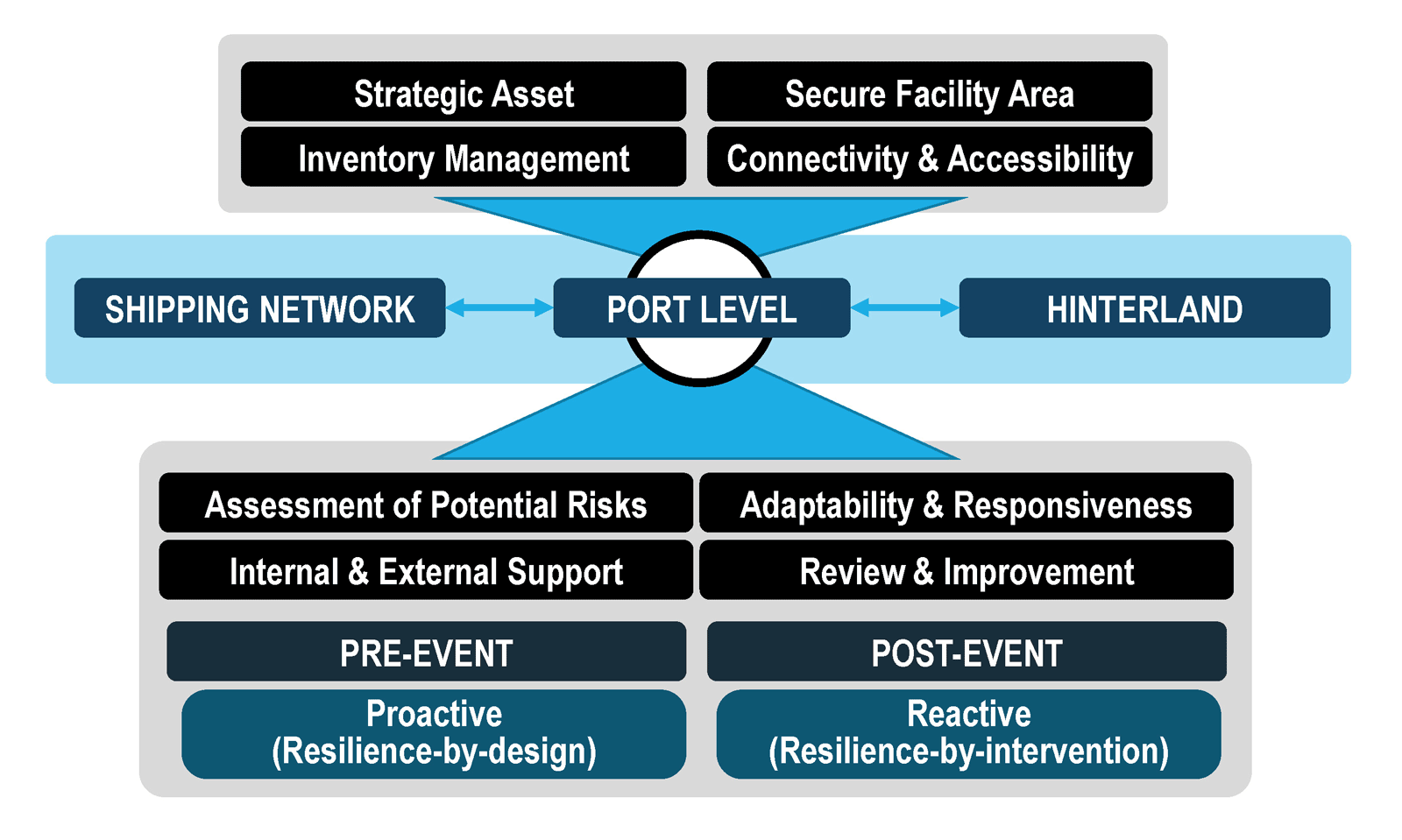A proposed perspective is to consider a port as a resilience platform that allows for the continuation of supply chains and the availability of transport capacities. This perspective includes four fundamental infrastructure and operational aspects (figure 45):
- Strategic asset. As a transport facility, a port provides access and distribution capabilities to global and national markets. Ports should be recognized as strategic assets of national importance and receive appropriate regulatory and financial support. They support the resilience of their hinterlands by maintaining inbound and outbound supply chains. This also includes power generation facilities, essential to maintaining electric power supply, many of which can be found in the vicinity of a port.
- Secure facility area. The port facility must be secured to promote safe access, which involves a perimeter and checkpoints. The core purpose is to maintain the operational capabilities of the port, which requires the presence of key personnel and equipment.
- Inventory management. Ports commonly have co-located logistical facilities (e.g. warehouses and distribution centres) that should be considered part of the secure perimeter. These logistical facilities support critical supply chains by ensuring the procurement of energy, parts, goods, food and medical supplies. During a disruption, these facilities are expected to continue their operations and provide storage of critical inventory.
- Connectivity and accessibility. Mainstreaming digital solutions and electronic processes in ports are needed to maintain their physical connectivity to the shipping network and accessibility to their hinterland.
Figure 45: The port as a resilience-building platform

A resilient port is a port that has:
- Identified, reviewed and prioritized any potential risks that could impair its operations and market position;
- Strengthened its adaptability and responsiveness to disruptions related to its most probable risks;
- Identified internal and external support structures that can be accessed to address unforeseen and rare disruptions; and
- Created an iterative process involving the reviewed and improvement of a resilience strategy, taking into account events, as well as new and emerging risks.
Resilience can be implemented proactively or reactively:
- Pre-event (resilience-by-design). Pre-event measures build the capacity of a system to recover and resume critical functions after an expected disruption, which is within the design parameters of the system, namely its infrastructure, operations and management; and what the port can do proactively.
- Post-event/during event (resilience-by-intervention). This includes post-event measures that react to the disruption, either on a planned or an ad-hoc basis, and what the port can do reactively when faced with a disruption. It assumes that internal and external resources will be available to stakeholders, as needed, to support system resilience. In addition to the resources available to the port, many governments have agencies designed to intervene and manage large-scale emergencies by offering supplies, relief and equipment to repair local infrastructure. This represents the support structure that the port can draw from. However, depending on the nature and the scale of the event, a support agency may be overwhelmed or have other priorities, such as providing relief to the population.
A review of the case studies shows that most ports have a post-event reactive approach and response to disruptive events, even when these events have a level of predictability (e.g. hurricanes and extreme weather events). Ports have a complex and capital-intensive infrastructure, which help explain inertia and the existence of default “resilience-by-intervention” approaches. However, this approach to risks and disruption is increasingly inadequate considering the growing importance of ports as trade, logistical and energy platforms. Therefore, a transition towards a more proactive view of resilience is important and is likely to have accelerated in the context of COVID-19 pandemic and recent geopolitical and climatic risks, and disruptions.
Port resilience-building should not be seen as a one-off solution but as a strategy and an ongoing process that can be gradually implemented and revised. It must be adapted and fine-tuned to the unique situational, governance, managerial, commercial, and infrastructural context that each port faces.
The success of port resilience-building measures depends on effective collaboration among all players, at the national and international levels, especially for transborder trade. Concerted efforts and coordinated action are crucially important, especially when tackling bottlenecks not only at the port and ship/port interface level but also along the hinterland, including landlocked, transit and coastal countries. In facing the challenges ahead, policymakers should ensure that financial support, technical cooperation and capacity-building are provided to developing countries, in particular the most vulnerable economies in LLDCs, LDCs and SIDS.
